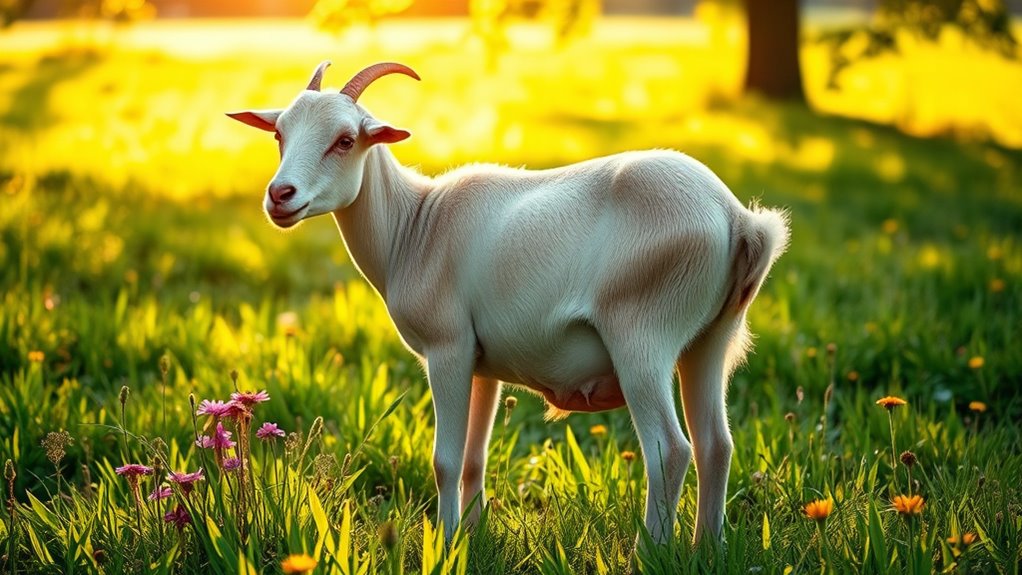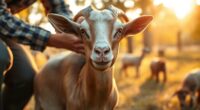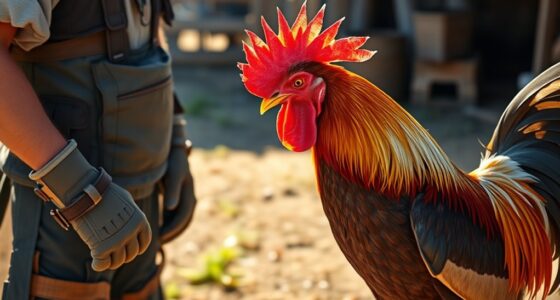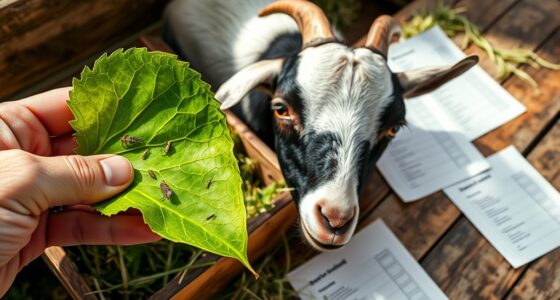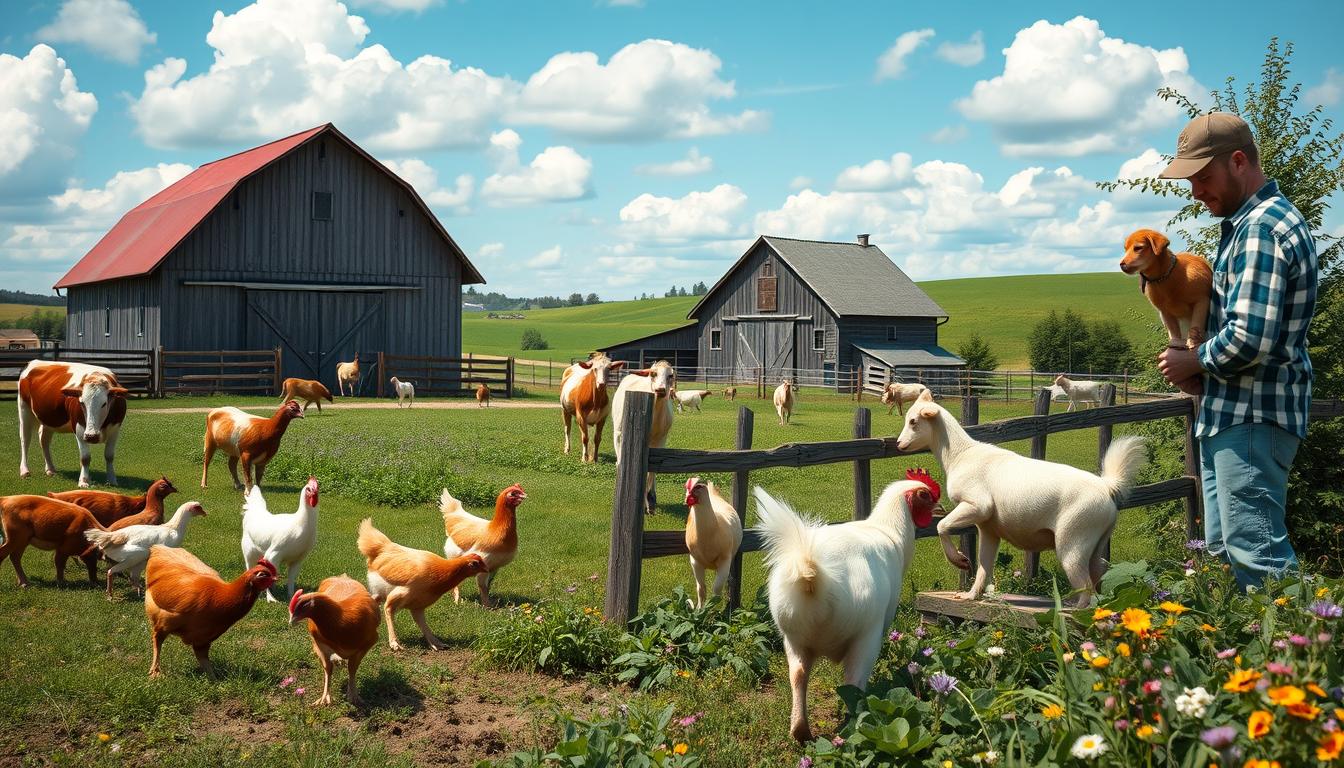When it comes to spotting signs of a pregnant goat, keep an eye out for key visual cues. Udder swelling and changes in belly shape are major indicators. You might notice weight gain and a saggy belly as the pregnancy progresses. Look for vulva changes such as swelling and discharge as labor nears. Additionally, observing movement helps confirm pregnancy. Understanding these signs can enhance your goat care knowledge and prepare you for what's next.
Key Takeaways
- Swollen udders indicate preparation for kidding, noticeable around six weeks post-breeding in first-time does.
- A tight belly that swells, especially on one side, signals advancing pregnancy stages.
- Weight gain is crucial; early pregnancy requires a balanced diet for consistent monitoring.
- A saggy belly often appears as the fetus grows, especially with multiple kids.
- Vulva changes include swelling and elongation, indicating that labor is approaching.
Udder Swelling
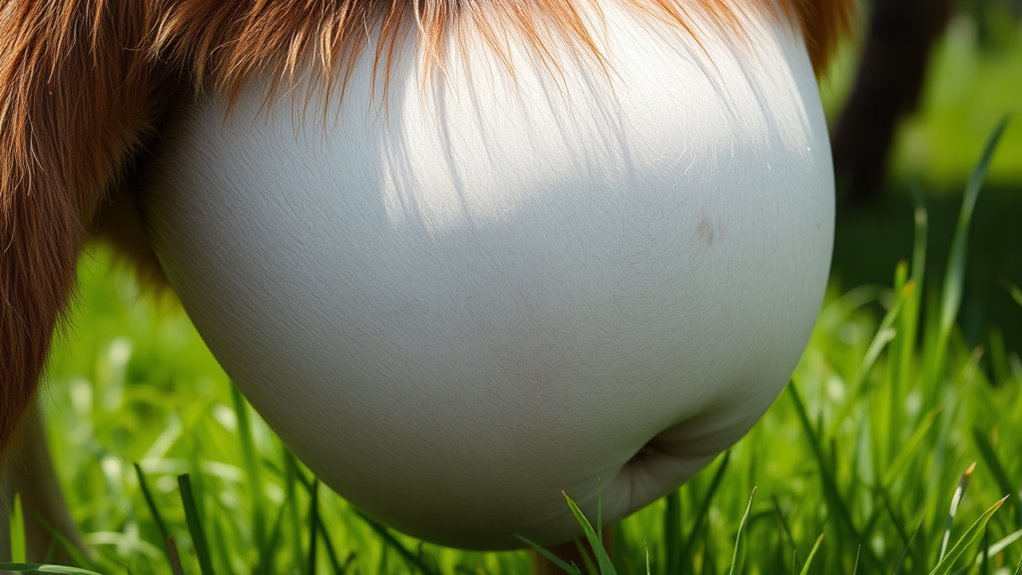
When you notice udder swelling in a pregnant goat, it's typically a sign that her body is preparing for the arrival of kids. This swelling usually begins about six weeks after breeding for first-time pregnant does, while those that have kidded before may not show noticeable changes until a month before kidding.
As the pregnancy progresses, the udder appears rounded and full, although the degree of swelling can vary among does.
Keep in mind that swollen udders can increase the risk of mastitis if not cared for properly. Regular hygiene practices, balanced nutrition, and monitoring are essential to ensure her udder health during this crucial time.
Your attention can make a significant difference in her well-being.
Belly Shape
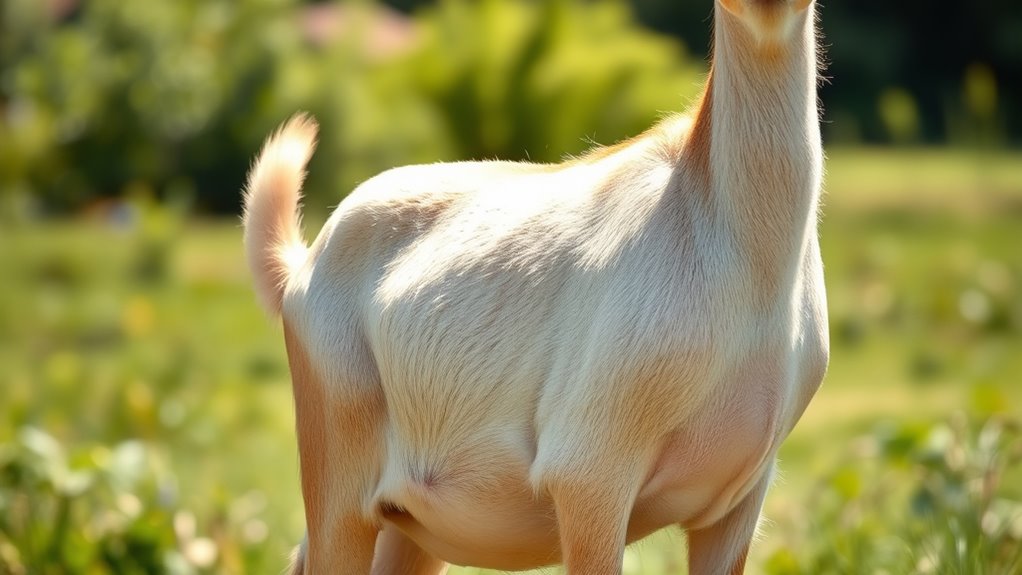
As you observe udder swelling in a pregnant goat, you might also notice changes in her belly shape. Early in pregnancy, the belly tightens, which you can feel by pressing just in front of the udder.
A noticeable swelling often occurs, sometimes appearing suddenly, giving her a larger belly. Depending on the position of the fetuses, swelling may be more pronounced on one side. If she's carrying twins, you might see bulging on both sides.
As the pregnancy progresses, her abdomen may take on a boat-like appearance, especially in the final weeks. Just before birth, expect to see a hollowed-out look as the kids drop, signaling that kidding is imminent.
Keep an eye on these changes!
Weight Gain

Weight gain in pregnant goats is a vital indicator of their health and the well-being of their developing kids. As a goat owner, you'll notice that weight gain patterns vary by breed and stage of pregnancy. For instance, Oberhasli goats typically gain more weight compared to Saanen goats.
Early pregnancy is crucial for consistent weight gain, and you should monitor it closely. Nutrition plays a key role; ensure your goats have a balanced diet with essential minerals. Overfeeding or underfeeding can lead to metabolic issues.
Pay attention to weight gain trends—up to 80 days, it's stable, but it slows from 80 to 110 days. In the final stages, fetal growth accelerates, so adjust feeding accordingly to support their health.
Saggy Belly
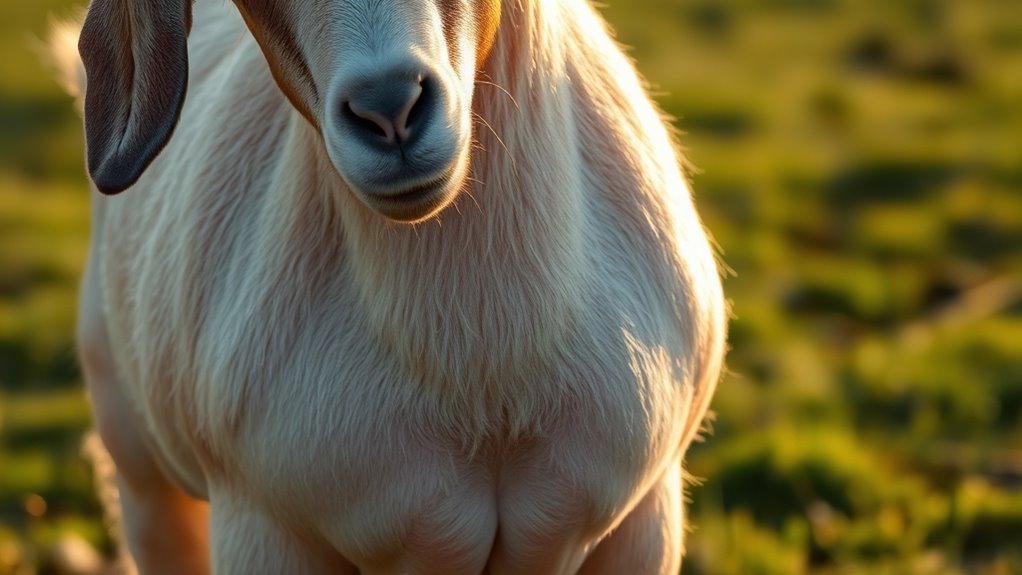
Noticing a saggy belly in your pregnant goat can be an important visual cue indicating her developing pregnancy. This saggy appearance means her abdomen may hang lower than usual, often due to the weight and positioning of the fetus or fluid accumulation.
You mightn't see this sign in early pregnancy or if she's carrying a single kid. As her pregnancy progresses, the abdomen may show a noticeable change, especially if she's carrying multiple kids.
Keep in mind that each goat's physical changes can vary, making a saggy belly less reliable as a sole indicator of pregnancy. Observing these changes alongside her behavior can provide better insights into her pregnancy status.
Rumen Swelling
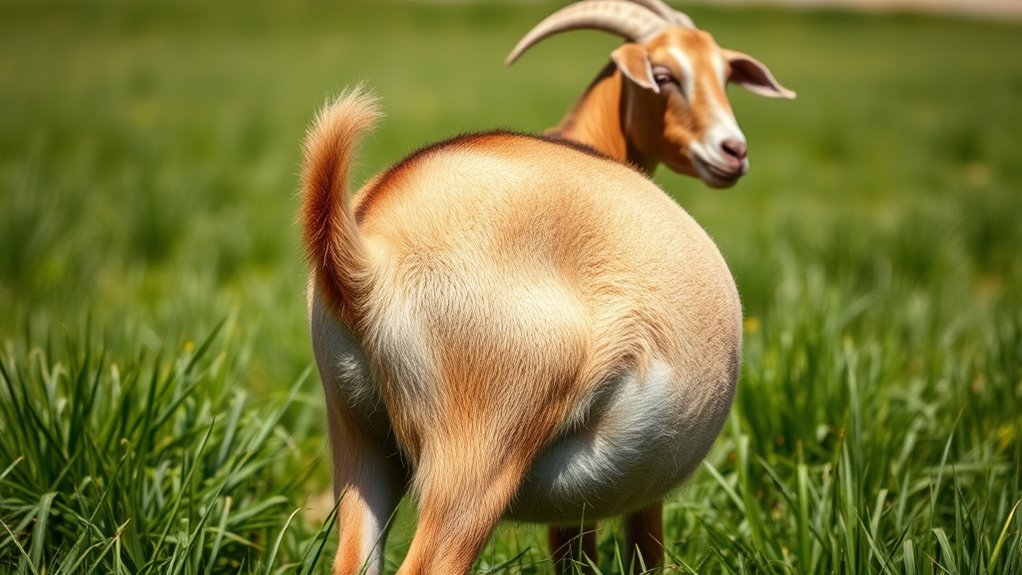
Rumen swelling is a common sign in pregnant goats, often resulting from the growing fetus pressing against the rumen.
You can distinguish this swelling from bloat by feeling the abdomen; a full rumen will feel softer, much like cookie dough, while bloat feels tight and hard.
If your goat's abdomen appears rounder or boat-like, it might indicate rumen swelling, especially if she's carrying multiple kids.
Regular palpation and visual inspection can help you monitor this condition.
Keep an eye on her dietary habits too, as high concentrate diets can lead to bloat, complicating the situation.
Vulva Changes
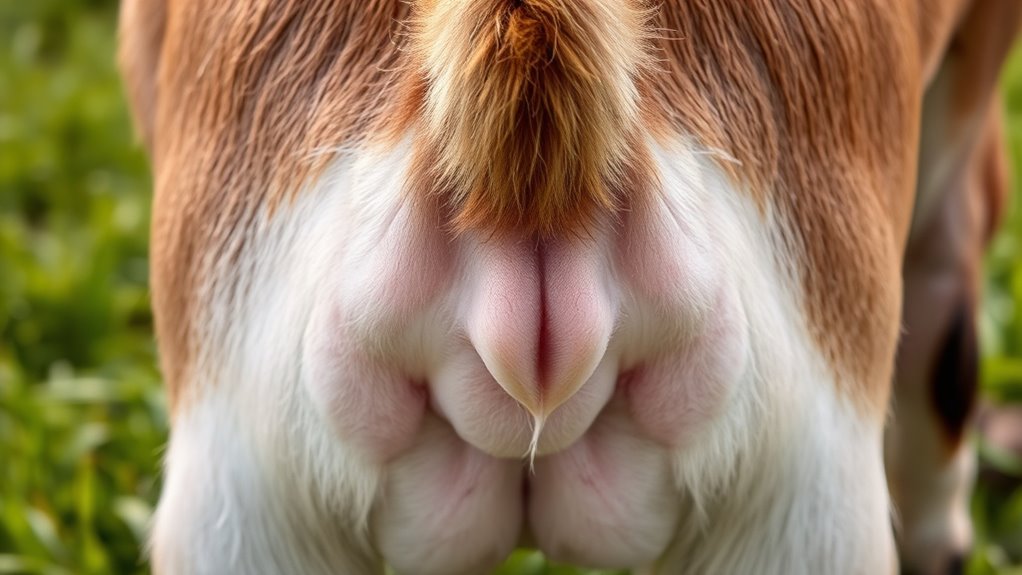
As your goat approaches labor, you'll likely observe noticeable changes in her vulva that signal impending kidding.
The vulva will swell significantly, often increasing from about one inch to two or three inches in length. You'll also notice a pinkish coloration, indicating that birth is near.
Along with these changes, the discharge from her vulva will become more pronounced, especially as the mucus plug is lost. This combination of puffiness and elongation is a reliable sign that kidding is imminent, usually within days.
Be sure to monitor her frequently for these signs, as they're crucial indicators that labor is approaching. Pay attention to her behavior, as restlessness often accompanies vulva changes.
Teat Changes

Teat changes in pregnant goats provide important clues about their impending labor. As a goat owner, you'll notice that the udder starts developing around six weeks into gestation, especially in first-time does. Initially, their teats may remain small and close to the body, but as parturition approaches, you'll see gradual swelling.
In seasoned does, udder swelling becomes noticeable about a month before giving birth, and teats may lengthen and increase in circumference. Around ten weeks pre-partum, the fluid in the teats transitions to a milk-like composition filled with immunoglobulins.
Movement Detection
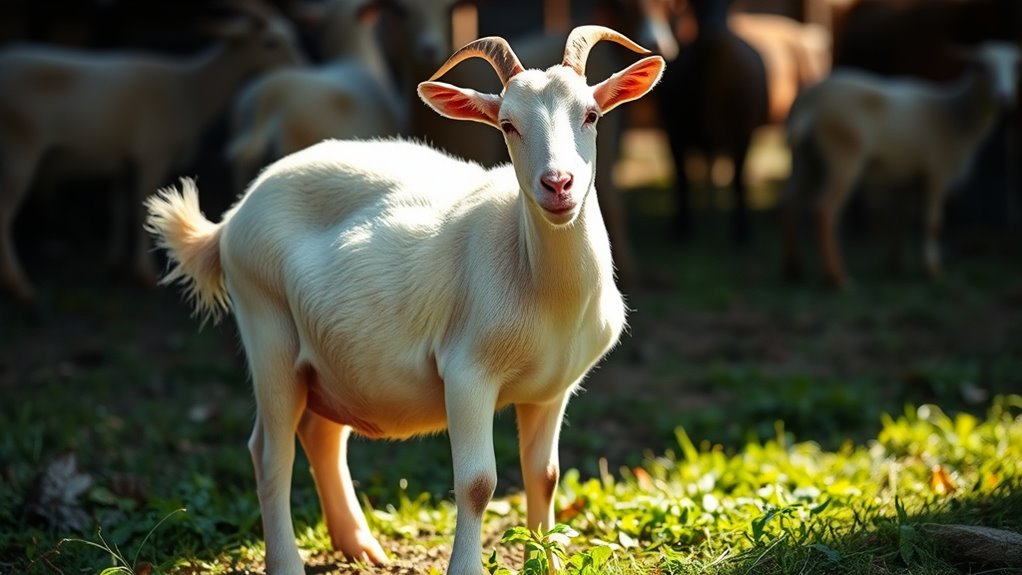
While monitoring your pregnant goat, you can detect fetal movement by gently pressing your hands against her right side and belly, just ahead of the udder. This technique works especially well if she's carrying multiple kids, as the movements will be more pronounced.
You might even notice visible kicks against her side as the fetus grows. Typically, you can start feeling movement around three-and-a-half to four months after breeding.
Using a flat hand, you can also feel for a nose or soft hoof by palpating the lower right side, just in front of the udders and inside the leg. These signs can help you confirm her pregnancy and monitor the health of the developing kids.
Frequently Asked Questions
How Long Is the Gestation Period for Goats?
The gestation period for goats typically lasts between 145 to 155 days, averaging around 150 days.
That's about five months!
When you're managing a pregnant doe, remember that various factors like breed size and nutrition can influence this duration.
Make sure to monitor her health and provide a balanced diet, as these elements are crucial for a smooth pregnancy.
Keeping an eye on her can help you prepare for the arrival of kids!
Can a Goat Have False Pregnancies?
Yes, goats can experience false pregnancies, with reports indicating that 6% to 30% of goats may be affected.
This condition, known as pseudopregnancy, occurs when sterile fluid accumulates in the uterus without a viable fetus.
You might notice symptoms similar to true pregnancy, like abdominal distension.
If you suspect a false pregnancy, consulting a vet for diagnosis and treatment options is crucial to ensure your goat's reproductive health.
What Should I Feed a Pregnant Goat?
When feeding a pregnant goat, focus on providing fresh, clean water and high-quality hay or pasture.
You should consider minimal grain supplementation unless she's underweight. It's essential to offer a trace mineral mix to meet her micronutrient needs.
Monitor her body condition regularly and avoid overfeeding, as this can lead to health issues.
As she progresses in pregnancy, gradually increase her grain intake to support her growing kids effectively.
When Should I Start Preparing for Kidding?
You should start preparing for kidding about a month before the expected due date.
Imagine a cozy barn, clean and inviting, where your soon-to-be mama goat can feel safe.
Gather your essential supplies like towels, iodine, and colostrum replacers, ensuring everything's ready.
Create a calm environment to ease her stress, and keep your vet's contact handy for emergencies.
With these preparations, you'll set the stage for a smooth and successful kidding experience.
How Can I Help During the Birthing Process?
To help during the birthing process, keep a close eye on the doe and monitor her behavior for signs of labor.
Create a clean, quiet space for her to feel safe.
Be ready with supplies, like iodine for the umbilical cord.
If complications arise, intervene gently, ensuring you use clean gloves.
After the kids are born, check that they're breathing and nursing, and monitor the doe for any health issues.
Conclusion
In the journey of goat pregnancy, spotting the signs is like reading a fascinating book; each chapter reveals more about your doe's condition. By observing udder swelling, belly shape, and other visual cues, you can better understand what's happening with her. Recognizing these changes not only prepares you for the arrival of kids but also strengthens your bond with her. Keep an eye out, and you'll be well on your way to becoming a goat pregnancy expert!

